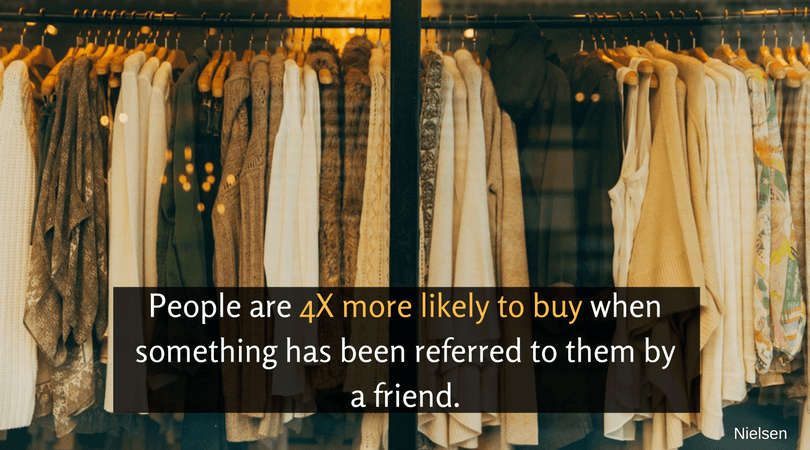What Is a Client Referral?
A client referral is a possible new client that is recommended to your business by one of your existing customers. It is when a customer refers you to others. A great client referral has an immediate need they can satisfy with your product or service and is willing to take a prospecting call from your sales rep.
Client referrals are like business referrals, which are when a person or company in your network recommends another to try your product or service.
This may occur naturally during a casual conversation or even as a result of deliberate referral marketing activity on the part of the referrer. Referrals can also come when people feel good about what they just did and want to share it with others.
If you deliver a positive client experience, word-of-mouth recommendations will occur on their own.
However, making a deliberate effort to grow client referrals and recommendations may result in a larger return on your investment from your connections. So every business must make it a priority to learn how to generate referrals from existing clients.
How to Generate Referrals From Existing Clients
Depending on how much you charge for your services and how many clients you take in at a time, client referrals could make up a large chunk of your lead generation strategy.
Once you satisfy, even a handful, of your accounts you could be getting valuable new connections.
Knowing how to get referrals is only a part of the picture. Most B2Bs and marketing agencies know to reach out occasionally, but very few have a process set up to automatically extract those warm leads into their contacts.
There is the time investment factor and you don’t want to lose progress if your outreach is working, but the stats could surprise you.

Key Stat: Research giant Nielsen says that people are 4X more likely to buy when something has been referred to them by a friend.
There’s a lot of psychology that goes into the “why” of people suggesting a product or service. Basically, when someone says we should try something it makes us want to try it.
10 Tips for Getting Client Referrals
Here is some advice on everything from asking for referrals at the right time, giving clients something to refer friends to, and even creating an irresistible offer for those who give referrals.
If you use these tips, your business will be growing faster than ever before.
1 Meet customers’ expectations
Establishing measurable goals is a critical component of running a successful business. However, while your aspirations for your workforce may influence their specific responsibilities and daily operations, they ultimately may not be the most significant expectations your staff should be striving to reach.
The reason for this is that your success is ultimately determined by how satisfied your consumers are with the services and products you deliver. Many businesses, on the other hand, appear to believe that their consumers’ expectations will be met by whatever they have to offer.
That rarely happens.
Instead, in order to get more referrals, you must spend some time learning about your consumers’ needs and then tailor your offerings, solutions, and customer service to meet their needs as effectively as possible. Aim to exceed their expectations.
2 Add a customer loyalty program
A strong loyalty program for your customers is an easy way to get referrals. It can significantly increase your company’s recurring profitability and increase the returns on your marketing spend.
Prior to implementing a client loyalty program, you must determine whether this is a viable strategy for your business.
The first step is determining the value of each customer to your company and the cost of acquiring them. This will assist you in determining whether to put more money into acquiring new clients or retaining and motivating existing ones.
Before you decide to have a loyalty program, you first should do a satisfaction assessment of your present customers using tactics such as questionnaires, interviews, and tracking customer remarks.
After doing that, find individuals that excel at customer service and are willing to join the program. You’ll want to target clients that make frequent purchases yet have the potential to become even more valuable.
Select loyalty-boosting strategies that are not only tied to a customer’s expenditures, but also to the strength of your company relationship.
3 Engage existing customers
Customer engagement is the process of developing a connection with the people who purchase your products. It involves all the ways you communicate with your customers. May it be through emails, phone conversations, or social media.
Developing a strategy for these encounters can assist you in keeping your clients happy—and in attracting new customers as well.
You need to have an engagement plan to increase customer satisfaction through good interactions.
Excellent tactics transform a reactive to a proactive client. It should cover how your team engages with clients who contact you independently and how your business can take the lead and involve your audience actively, which will then help you generate referrals.
4 Provide valuable content
Content marketing has progressed from being a novel marketing notion to becoming an important promotional force for nearly every company across every industry over the past several years.
The greater the caliber of your material, the more useful it is to your customers, and the more probable it is that they will associate with your company’s offerings.
Your clients’ engagement with your company and the time they spend on your website increases the likelihood that they will develop confidence in your brand and eventually become potential clients.
As a result, you will receive a significant yield on your content marketing campaign.
Your consumers will grow to respect and count on you as a provider of specialist knowledge, and they will reciprocate by giving you their cash and showing their commitment to your brand.
Who knows? They could also refer your business to other prospects.
5 Make the experience shareable
Providing excellent client experiences for your company takes more than just providing excellent customer service. You must spend time getting to know your clients and creating long-term investments in order to create tailored experiences throughout their journey.
It has been established that excellent customer service increases loyalty, engagement, and income.
Allowing consumers to submit reviews is a terrific way to get started. However, don’t assume those customer evaluations are the sole way for them to voice their thoughts and opinions.
When customers are pleased with your product or service, they are eager to tell others about it. So, demonstrate to them how they can do this.
Identify the consumers who are raving about your business, goods, or services over the internet and highlight those who are saying positive things about you.
6 Use LinkedIn to ask for client referrals
Your business is already excellent at what it does, and your customers are also well aware of this; now it is time for them to give their thoughts!
In contrast to many other social media platforms, LinkedIn devotes an entire section of your account to “Recommendations,” which function as casual references for anybody who visits your profile and views your reviews. To market your company, make use of this part to reach out to your network contacts and potential customers.
The recommendation option on your customer’s LinkedIn page allows you to request a referral.
If you contact your connection via another site, it is possible that they will become more receptive to your request. Take into account the fact that, on average, individuals check their mail 1-3 times per day and their cellphones more than 150 times.
Make this external approach friendly by directing them to your LinkedIn profile and providing them with instructions on how to send a recommendation.
Your LinkedIn contacts are supplying you with an untapped, free prospective consumer base. It is possible to see the connections of a user once you’re a first-level link to them, such as a former client or business colleague. Take advantage of these features to get referrals.
A personal recommendation offers you a better opportunity to develop connections and advertise your services and products than a formal introduction.
7 Adopt a customer referral program
An effective customer referral program allows your staff to be active when it comes to getting referrals by utilizing existing customers.
Your consumers will sense your confidence and therefore will feel more at ease giving information to you as a result of the well-organized approach you have in action.
Customer referral programs increase the reputation of your company, making it possible for customers to place their trust in you.
It is easier to get referral clients when you give existing clients some incentives as part of the company’s referral program.
8 Offer incentives and rewards
To enhance the offer and ensure that your existing customers explore their connections for a great referral opportunity, provide them with something of value in exchange for their time and effort.
Reward your customers for linking you with warm leads.
Organizing reward packages in a centralized location is one choice. Another option is to establish a system that controls customer referral agreements.
Client referral agreements can assist your company in generating significant amounts of new leads on a consistent basis by establishing a system that recognizes and rewards key clients.
9 Align with your customers’ values
Conduct market research to understand what your consumers genuinely desire before approaching them with the request for a reference. Then you’ll be able to link your reward or recognition with those ideals.
You’ll also be capable of offering them a sense of the influence they’ll have as a result of a referral they make.
When your consumers realize that you have the same beliefs and goals, they are more inclined to recommend you to others.
Remember that you should be sincere in your commitment to these principles, rather than simply utilizing them as a means to further your company’s interests. Customers can tell when you’re insincere, and they will not hesitate to discuss it with others.
10 Act on positive feedback
Feedback, in whatever form, is a benefit since it gives you a chance to observe your company from the perspective of your customers.
It leads to better business decisions. You’ll also be able to engage with them on a profound level and continuously fulfill their needs, which will result in returning customers and client referrals from them.
In order to get more referrals, you must first demonstrate that you are worthy of being referred.
Making sure you’re fulfilling (and surpassing) the demands and expectations of your current customers are essential if you want to generate referrals from them.
Before we discuss how to ask for a referral from an existing client, here are a few more tips to get more referrals from your network:
Get Referrals By Boosting Your Clients’ Confidence
People want to talk about your stuff for selfish reasons.
Think about it.
When you’re having a conversation and someone mentions a problem that you know the solution to, you want to tell them. Not necessarily to be helpful (at first), but because you have the answer.

It becomes about helping eventually, but when the light bulb goes off in your head—you’re excited to have something to say.
Social currency, proving your value, it’s basic human nature.
Even if what you do solves a problem and your clients have colleagues who could use your services, they may not mention you. Why?
Well, it’s a matter of three things (or steps):
- Education (how well your clients know what it is you do)
- How easy it is to suggest your stuff to others
- Whether or not you asked them
1. Educate your clientele

When I started in content marketing, I didn’t know anything.
But I did ask for referrals. I’d send out a quick email with a few of my core services, and every time clients would say, “I didn’t even know you did X.”
It got me some more business from those clients, but it didn’t get me many new clients.
It’s important to know that even if you have good word of mouth (which is great), you’re going to have to ask current customers for an introduction.
The (automated) solution:
A good post-sale funnel is the best way to convey all that you have to offer.
Doing this through a drip-fed email sequence over the first month of signing a new client will really get the ball rolling toward lots of referral opportunities.
When they see you offer FB ads, and they just had a business luncheon where Jane Doe said they needed to find a person who does just that, you’re one step closer to referrals.
Note: Doing this is especially important for marketing agencies. You probably have drop-down menus on your drop-down menus to show all of your services. Most of your paying customers don’t know half of what you do—yet.
2. Make it easy to refer your services

The other major roadblock keeping your happy buyers from suggesting your services to others is the logistics of doing so.
While natural conversations where your services come up do happen, it’s not that often. So, getting client referrals “out of season” has to be easy enough for your accounts to want to reach out to their colleagues without a clear reason.
The (automated) solution:
There are a number of ways to make client referrals easy.

-
- Start a Business Referral Program:
Your services could warrant business referrals all on their own, but incentivizing clients into referring their colleagues works well.
This subject could warrant an entire post of its own (and may one day), but here’s a list (from ReferralCandy) of 47 actual programs in existence to get your brain flowing in the right direction.
- Create a specific landing page:
If you want these leads to be a permanent source of business, you have to devote some resources to the strategy. A specific landing page for all business referrals is a nice touch to show you mean business.
If you really want to get fancy, create a custom page with either the name of your lead and/or your client. (How: When a client says they have a lead, just ask who it is and send them a custom link.) Works like a digital red carpet.
- Have a Scheduling System:
Don’t, repeat—do not—ask for a referral only to have to send a “let me check my schedule” message to the new lead. This is an egregious error, especially in the internet age.
Use Calendly, or something similar to set up when you’re available and let them choose a time that’s best for them.
All that is well and good, you say, but how do you ask for referrals from existing clients? What is the process – the actual steps?
How to Ask for a Referral From a Client, Step By Step

Even if you do everything you can to make it easy for your clients to refer you, they may not pick up what you’re laying down (is that still a phrase people use?).
Anyway—you will have to ask most of your clients, point blank, to tell their friends. Here are the steps to do that:
-
Make a (not-so) automated solution
We love automation. Just about anything can be automated to a certain extent. If lead generation can be put on autopilot, every aspect of the business could be systematized to a point.
That said, you will get a lot further at times with a personal touch. I mean, they are your clients.

Step 1 – Schedule a call
I understand this is not going to be possible for everyone. It’s also dependent upon your price to lead numbers.
If a couple of leads make your week/month, why wouldn’t you call leads to make referral business happen? It’s the highest level of personalization to call, see how they’re doing, and ask for their contacts.
Ask early for the referral. As with most things in business, timing is everything
There is a grace period to getting referrals from clients. A sweet spot to get the news to spread. Aim for no later than 30 days after the initial sale. Ideally, your client will have seen some success from your work and still not have lost that warm and fuzzy feeling before what you do becomes the norm.
When they expect the results you give, it’s less likely they’ll think about referring you.
Step 2 – Follow up with an email
You probably didn’t win their business on the first cold email and you won’t always get them to comply on the first referral business attempt either.
Throw a quick reminder in their inbox.
You can mention your first contact, any benefits you offer for successful referral business opportunities, and what you’d like them to do (e.g. send a group email, schedule a lunch, or send them to a landing page).
You will likely get your referral, but don’t stop there.
Step 3 – Make the client referrals last
Keeping the referral train going isn’t just a matter of pragmatics (like the stuff listed above). There are a couple of “common sense” tips that can help you entice clients to bring their acquaintances into the fold. One is to exceed the referral client’s expectations so they can refer you to others.
Rinse and repeat, or:
Step 4 – Target similar clientele
Picking an industry (or two) where you can focus your efforts isn’t just a good sales tactic, but an overall great way to establish authority in your niche.
You’re not just a marketing agency, you’re the agency that helps [insert your ideal client here] achieve [insert your unique value proposition here].
After a while of helping a similar audience, they’ll not only refer you to colleagues—you’ll be known as the best. At this point, you move from referral lead generation to authority lead generation.
How to Get More Referrals for Your Business
Quality trumps process in terms of longevity.
The only way to keep the referrals train moving and get more referrals from your existing clients is by doing a good job.
There is no substitute for a job well done.
Satisfaction of your clients is the only real way to ensure that you’ll have repeat business, let alone referral business opportunities.
You’re only ready to use any of the tips we’ve offered in this post after you’re already delivering on your promises that you sold current clients.
Without that aspect of the business in full swing, your customers will never suggest you to anyone else.
So, even if you are running a tight ship, take some time before you run any referral program to make sure you’re over-delivering.
If you know that the results could be better, but you’re concentrating on how to get referrals— get off this site and get to work.
TL;DR – How To Get Referrals From Clients
You can incorporate all the tips we shared to a T, but your customers will not recommend you to their peers if they are not satisfied with their experience with you or your product.
Customers will more likely to moan about your poor service or product than they are to tell their neighbors about the awesome experience they have just had with your business.
In summary:
More than just exceeding their expectations, make it easy for them to recommend your products. If they still won’t do it on their own, ask them. Still, some will not be too keen, which are those you may want to incentivize and get your referral.
Want to help contribute to future articles? Have data-backed and tactical advice to share? I’d love to hear from you!
We have over 60,000 monthly readers that would love to see it! Contact us and let's discuss your ideas!

